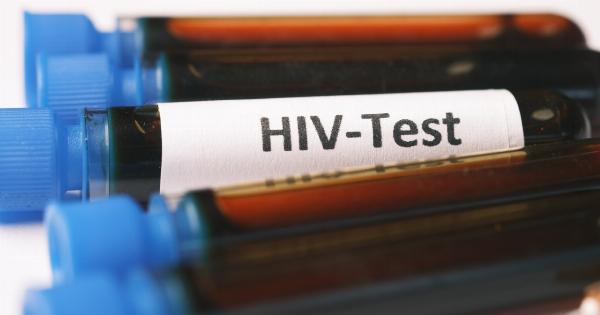HIV testing plays a crucial role in public health as it helps in identifying individuals who are infected with the human immunodeficiency virus (HIV).
By detecting HIV early through testing, appropriate medical care and interventions can be provided, reducing the transmission of the virus and improving the overall health outcomes for those living with HIV. This article explores the importance of HIV testing in the context of public health and its impact on individuals, communities, and society as a whole.
The Importance of HIV Testing
HIV testing is essential for several reasons. Firstly, it allows individuals who are infected with HIV to receive the necessary medical care and treatment promptly.
Early detection allows for timely interventions, such as antiretroviral therapy (ART), which can help slow down the progression of the disease and improve the quality of life for those living with HIV.
Secondly, HIV testing helps reduce the transmission of the virus. People who are unaware of their HIV-positive status may unknowingly engage in behaviors that put others at risk.
By identifying HIV-positive individuals, they can be counseled on safer sex practices and referred to prevention services. This not only protects their partners but also helps to curb the spread of HIV within communities.
Thirdly, HIV testing is an essential component of HIV prevention strategies.
In addition to counseling and education on risk reduction, testing also provides an opportunity for individuals to access other preventive measures, such as pre-exposure prophylaxis (PrEP) for those at high risk of acquiring HIV. Identifying new HIV infections through testing also allows public health authorities to target resources and implement effective prevention initiatives.
HIV Testing Methods
There are various HIV testing methods available that offer accurate and reliable results.
The choice of testing method may depend on factors such as the availability of resources, the window period of detection, and the preferences of the individual being tested.
1. Antibody Tests: These tests detect the presence of HIV antibodies produced by the immune system in response to the virus.
They are usually performed on blood or oral fluid samples and can be conducted in a laboratory or as a rapid test, providing results within minutes.
2. Antigen Tests: These tests detect a protein called p24, which is part of the HIV virus. They are highly sensitive and can identify HIV infections earlier than antibody tests.
However, confirmatory testing is required for positive results.
3. Nucleic Acid Tests: These tests directly detect the genetic material (RNA) of the virus. They are highly accurate and can detect HIV infections earlier than both antibody and antigen tests.
However, they are more expensive and are mainly used for confirmatory testing in high-risk situations.
4. Home Testing Kits: These kits allow individuals to test themselves for HIV in the privacy of their own homes. They usually involve collecting a sample such as blood or oral fluid, which is then sent to a laboratory for analysis.
Results are typically provided confidentially over the phone or online.
HIV Testing and Stigma
Despite the importance of HIV testing, stigma surrounding HIV/AIDS remains a significant barrier for many individuals. Fear of discrimination, judgment, and social repercussions often prevent people from getting tested.
To address this issue, it is crucial to create a supportive and non-discriminatory environment that encourages and facilitates HIV testing.
Healthcare providers and public health organizations play a vital role in reducing HIV-related stigma. By training healthcare professionals to provide non-judgmental and empathetic care, individuals may feel more comfortable seeking testing services.
Community outreach programs that aim to educate the public about HIV transmission, prevention, and the importance of testing can also help reduce stigma and promote testing as a regular part of healthcare.
Access to HIV Testing
Ensuring access to HIV testing is critical in reaching high-risk populations and achieving public health goals.
Testing services should be readily available, affordable, and offered through various settings, including healthcare facilities, community centers, and outreach programs.
Some strategies to enhance access to HIV testing include:.
- Expanding the number of locations where testing is available, such as pharmacies and community centers
- Offering free or low-cost testing services
- Providing mobile testing units in underserved areas or at community events
- Promoting awareness about HIV testing through educational campaigns
- Implementing routine HIV screening in healthcare settings
By implementing these strategies, it is possible to make HIV testing more accessible to those who need it, reducing barriers and ensuring that individuals receive the testing and care they require.
HIV Testing in the Era of COVID-19
The COVID-19 pandemic has posed additional challenges to HIV testing and public health efforts.
Lockdowns, restrictions on movement, and overwhelmed healthcare systems have disrupted routine testing services and hindered individuals’ ability to access them.
However, some innovative approaches have been developed to address these challenges. Telemedicine and telehealth services have expanded, allowing individuals to access counseling and testing remotely.
Mobile applications and online platforms provide information on testing locations and self-testing options. Social media campaigns and virtual outreach programs have also been used to raise awareness about HIV testing during the pandemic.
Public health agencies and organizations have adapted their strategies to ensure that HIV testing services continue to be available despite the COVID-19 pandemic.
By leveraging technology and community partnerships, they strive to minimize the impact of the pandemic on HIV prevention and care.
The Future of HIV Testing
Advancements in technology and research continue to shape the field of HIV testing. Efforts are underway to develop more accessible, user-friendly, and accurate testing methods.
Point-of-care tests that provide rapid results within minutes are becoming increasingly available. These tests eliminate the need for follow-up visits and allow for immediate initiation of treatment if needed.
Self-testing kits are also being improved to enhance ease of use and accuracy, empowering individuals to take control of their own health.
In addition to traditional laboratory testing, new technologies such as smartphone apps and wearable devices are being explored for HIV testing and monitoring.
These innovations aim to make testing more convenient and integrated into daily life, further reducing barriers to access and increasing testing rates.
Conclusion
HIV testing is an integral part of public health efforts to combat the HIV/AIDS epidemic. By identifying HIV-positive individuals early, appropriate care can be provided, transmission can be prevented, and communities can be protected.
It is essential to continue advancing HIV testing methods, reducing stigma, and ensuring access to testing services for all. With continued progress and collective efforts, we can strive towards an HIV-free future.































